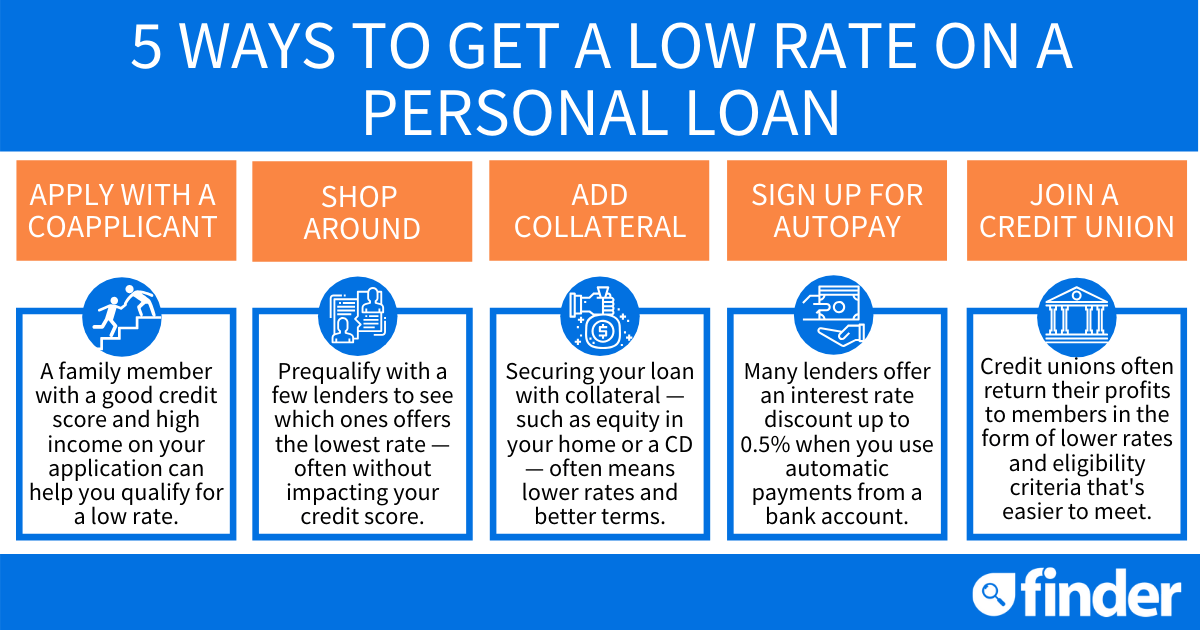The average personal loan interest rate was 10.28% in the first quarter of 2022, according to the Federal Reserve. In general, the interest rate you receive on a personal loan will range from a low 4% to a high 36%.
To score the lowest rates, you need to have excellent credit. Some experts identify 760 or higher as the sweet spot. Other aspects of your finances, the loan term and the amount you apply for can also influence your rate.
We reviewed over 130 lenders before selecting lenders with the best personal loan rates. Comparing offers from multiple lenders can help you find the best deal available.
Interest rate vs. APR: What you need to know
Banks, credit unions and online lenders often interchangeably use interest rate and annual percentage rate (APR) as if they’re the same thing. But there’s an important distinction. When you’re looking at the average interest rate on a personal loan, you’re seeing a number that doesn’t include regular fees.
An APR is the percentage of your loan balance that you pay in interest and fees over the course of a year. An APR only includes fees you’re required to pay if you take out a loan.
The most common fee associated with personal loans is an origination fee, which covers application costs. These tend to range from 1% to 6% of your loan amount and are either added to or subtracted from your funds before you receive them. If you take out a line of credit, your APR might also include annual fees.
Your APR doesn’t include every possible fee that you could pay if you take out a loan. Late fees, prepayment penalties and nonsufficient funds (NSF) fees are all counted separate from the APR.
Personal loan interest rates
Personal loan interest rates depend on a wide range of factors, including your credit score and the type of financing you get.
Interest rates by credit score
Your credit score is one of the most important factors that lenders use to determine the interest rates you qualify for. The two credit scoring models are FICO and VantageScore 4.0.
It’s not a perfect science, and FICO and VantageScore have some differences, but your credit scores can help you predict what interest rates you may receive when borrowing credit and help you choose a lender that can accommodate your credit rating.
| Credit score range | Average estimated interest rate (%)* |
|---|---|
720+ | 12.55% |
680-719 | 19.60% |
660-679 | 30.16% |
640-659 | 41.55% |
620-639 | 55.31% |
580-619 | 83.61% |
560-579 | 117.42% |
Less than 560 | 158.87% |
*Source: LendingTree consumer data, Q4 2022.
While some personal loans stop at 36%, fair and bad credit borrowers can struggle to qualify for a personal loan at all. In many cases, they may be turning toward short-term loans like payday and installment loans. These can come with rates that top 300%.
Interest rates by financing type
Lenders tend to price different types of financing differently. Here’s how personal loan rates compare to credit cards and car loans from banks in the beginning of 2020.
| Type of financing | Average rates at a bank |
|---|---|
Personal loan | 9.09% |
Car loan (48 months) | 4.58% |
Car loan (60 months) | 4.67% |
Credit card | 14.51% |
Source: Federal Reserve Consumer Credit Statistics, Q3 2021
Personal loans vs. credit cards
As you can see from the Federal Reserve data, credit cards tend to have a higher average interest rate than personal loans. Unlike credit cards, a fixed-rate loan has a set interest rate.
This means interest payments don’t fluctuate — helping the average interest rate be a little lower. You can also borrow more on overage, even with a lower credit score.
But personal loans don’t come with some of the benefits of a credit card. This makes personal loans a bad choice for regular spending — but a great choice for expenses like debt consolidation.
What is a good interest rate on a personal loan?
While the average personal loan interest rate was around 10.7% as of September 2021, the average rate was a touch over 10% higher a year later at 11.89%. Generally, any interest rate under 12% is generally considered a good interest rate.
Personal loan interest rates vary widely depending on your credit score. So if you have good to excellent credit, you can expect to receive an interest rate around the average.
But for those with poor credit, you can expect higher interest rates. While these may be higher than the national average, they can still be good — especially if you have a shaky credit history.
Average personal loan rates from top lenders
Most borrowers won’t qualify for the lowest advertised interest rate. So we considered the full range of rates lender offers when coming up with this list.
We also didn’t exclude offers that are only available to a select few borrowers such as community bank, local credit union or invitation-only loans. And we limited the number of connection services — many share the same lowest rates because they work with similar partners.
The interest rate you receive will depend on factors like your credit history, annual income and overall financial situation. Prequalify with multiple lenders to find the best personal loan interest rate available to you.
Online lenders
| Lender | APR range | |
|---|---|---|
Avant | 9.95%–35.99% | |
Best Egg | 6.99%–35.99% | |
Earnest | 2.49%–17.24% | |
FreedomPlus | 8.99%–29.99% | |
Laurel Road | 9.99%–24.5% | |
LendingClub | 6.34%–35.99% | |
LendingPoint | 7.99%–35.99% | |
LightStream | Competitive | |
OneMain Financial | 18%–35.99% | |
Happy Money | 8.95%–17.48% | |
Prosper | 8.99%–35.99% | |
Rocket Loans | 9.12%–29.99% | |
SoFi® | 9.49%–29.99% | |
Upgrade | 7.99%–35.99% | |
Upstart | 6.7%–35.99% | |
Monevo | 5.4%–35.99% | |
LendingTree | As low as 5.99% |
Banks and credit unions
| Lender | APR range | |
|---|---|---|
Alliant | Starting at 10.49% | |
Citibank | 11.49%–20.49%* | |
Citizens Bank | 7.99%–20.89% | |
Discover | 7.99%–24.99% | |
Marcus by Goldman Sachs | 6.99%–24.99% | |
M&T Bank | 8.49%–15.74% | |
Navy Federal Credit Union | 8.99%–18% | |
PenFed | Starting at 8.99% | |
PNC Bank | As low as 6.39% | |
Santander | 6.99%–24.99% | |
TD Bank | 8.99%–23.99% | |
U.S. Bank | 7.99%–24.99% | |
USAA | 8.29%–18.51% | |
Wells Fargo | 6.99%–24.49% |
Banks tend to have lower interest rates
Online lenders are fast, but they often charge more for the convenience — notable exceptions being SoFi and LightStream. A 36-month personal loan from a bank had an average interest rate of 10.09% — slightly higher than the national average for a 24-month personal loan. But credit unions only had an interest rate of 8.95%, according to data from the National Credit Union Administration.
Banks and credit unions are able to offer lower average interest rates because they usually only work with current account holders.
That being said, the average personal loan rate doesn’t differ significantly between banks and online lenders. You may be able to find lower personal loan rates with banks, but that doesn’t mean you’ll qualify.
Your best course of action will be to compare personal loans from both banks and online lenders before you make a final decision.
9 factors that impact interest rate
The average personal loan interest rate is typically based on requirements and conditions lenders set. But there are a few common factors that influence rates with every personal loan lender.
- The better your credit score and credit history, the more likely you are to qualify for a competitive interest rate below 10%.
- Opting for a smaller loan amount is a good way to score an interest rate on the lower end of the spectrum.
- A shorter loan term will have higher interest rates on average. But long loan terms, even with lower interest rates, often cost more overall.
- Some lenders will offer a rate discount between 0.25% to 0.50% off your APR — that’s interest plus fees — when you sign up for autopay.
- Fees don’t directly impact your personal loan interest rate. But since an origination fee or application fee is worked into the APR, it will have an affect on the overall cost of your loan.
- A cosigner or coapplicant with good to excellent credit can help lower your interest rate by agreeing to take on shared responsibility for your loan.
- A secured loan will often have lower average interest rates than an unsecured loan. If you have a savings account, CD or other collateral, you may be able to use it to secure your loan and qualify for better terms.
- Having a higher income is a good way to get a personal loan with a lower interest rate. But no worries if you don’t have the best income out there. Your debt-to-income ratio often matters more.
- Your debt-to-income ratio is the percentage of debt you have compared to your income. The lower you’re already paying on loans and credit cards, the better your chances of getting a good interest rate.

How to compare APRs on a personal loan
These tips can help you make a more accurate comparison.
Compare lenders by more than only interest rate
Personal loan interest rates are one of the most important factors when it comes to how much you spend. But they’re not the be-all, end-all when you’re looking to keep your monthly payment low and your costs down.
APR: A lower interest rate doesn’t mean much if the fees that your lender charges make the APR higher than other personal loans you qualify for.
Discounts: Any discount to your interest rate or APR can significantly reduce your costs. Not all lenders offer discounts, so be on the lookout for those that do.
Fees: There are no-fee personal loans out there. While it’s uncommon, lenders like SoFi won’t charge origination fees, prepayment fees or late fees. But even a lower late fee can make the difference when it comes to the right personal loan.
4 common personal loan fees
Your personal loan interest rate isn’t the only expense that you need to take into account. Weigh these other expenses when you compare lenders.
- Some lenders charge an origination fee of around 1% to 5% of the loan amount at closing. Some deduct this from the funds you receive, while others add it to your loan balance. This is the only fee included in the APR.
- Most lenders charge a flat late fee of around $15 to $35 or 5% of the payment due. Most also have a 15-day grace period before the late fee kicks in. This is also not included in the APR.
- A nonsufficient funds fee (NSF), also known as a returned check or returned payment fee, will be charged if a payment bounces from your account. Typically it’s the same as a late fee, though sometimes it’s slightly higher.
Be aware of your monthly payment
Your monthly payments have the most immediate effect on your budget and are arguably the most important cost to consider when you apply for a loan. Monthly payments are based on the amount, rate and repayment term of your loan.
When you apply for a personal loan, you must show that you consistently have a high enough income and low enough debts to cover the monthly payment over the life of the loan.
Longer loan terms can give you higher monthly repayments. But that will increase the overall cost of your loan. Go for the shortest loan term you can afford to save on the monthly and total cost.
How do I calculate APR?
Follow these steps to calculate APR on a loan:
1. Add up the fees and interest you’d pay over the life of a loan.
2. Divide the result by the loan amount.
3. Multiply the result by 365.
4. Divide the result by the number of days in the loan term.
5. Multiply the result by 100.
Calculate how much you might pay
Using the average interest personal loan interest rate, you can estimate your monthly payment by entering your desired loan amount, loan term and interest rate into our personal loan calculator.
Feel free to experiment. Loan amount and loan term affect monthly payment as much as interest rate, so see what yours could be with different settings.
Bottom line
The key to getting a competitive rate on a personal loan is comparing lenders. While almost every lender considers your credit score, each has their own method of evaluating your application that could result in a higher or lower rate.
You should compare low-interest personal loans to find some of the most competitive interest rates out there. And here are some top lenders we compare — including their APR range, minimum credit score requirement and the loan amount they offer.
Compare other products
We currently don't have that product, but here are others to consider:
How we picked theseWhat is the Finder Score?
The Finder Score crunches 6+ types of personal loans across 50+ lenders. It takes into account the product's interest rate, fees and features, as well as the type of loan eg investor, variable, fixed rate - this gives you a simple score out of 10.
Ask a question
More guides on Finder
-
How to Survive Music Festival Season on a Budget (2025)
A guide to enjoying the festival season on a budget and tips and tricks to save money while you party.
-
Reprise Financial vs. OneMain Financial: Which is Better?
Considering a loan from Reprise Financial or OneMain Financial? Check out our side-by-side comparison first.
-
Large Personal Loans Over $50K, $100K and More
$50K+ personal loans exist, but most borrowers don’t know where to find them. Do you?
-
Pennie Financial Loans Review: Avoid This Misleading Company
A review of Pennie Financial, a company that appears to be a personal loans marketplace but likely shares your information with debt settlement partners.
-
Guaranteed Approval Loans for Bad Credit: Where to Apply?
Legit lenders don’t offer guaranteed approval loans, but some options come pretty close if you can meet the lenient requirements to qualify.
-
BHG Financial Personal Loans: Good for High Income Borrowers
Bankers Healthcare Group isn’t just for licensed healthcare workers. Compare large loans up to $200,000 with this legit online lender.
-
Best Debt Consolidation Loans
Compare 11 lenders to find one that’s a good fit for your needs.
-
Personal Loans and Grants for Felons
Loan and grant opportunities for people with a felony, what you need to qualify for loans and other resources for people who were formerly incarcerated.
-
Eloan Personal Loans Review
With Eloan take advantage of a convenient online application, but be wary of potential scams.
-
OneMain Financial personal loans review
Explore OneMain Financial’s personal loans with low requirements, quick approvals and options for all credit types.

